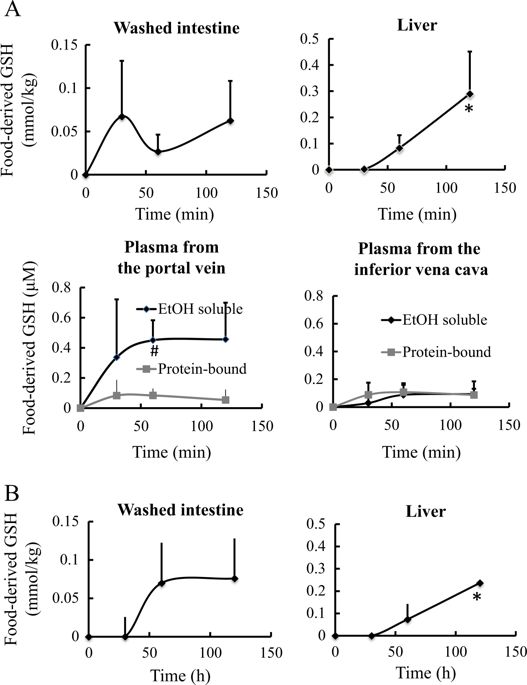npj Science of Food ( IF 6.3 ) Pub Date : 2018-02-06 , DOI: 10.1038/s41538-018-0011-y Hiroaki Yamada , Shinn Ono , Sayori Wada , Wataru Aoi , Eun Young Park , Yasushi Nakamura , Kenji Sato

|
Oral administration of glutathione has been demonstrated to reduce exercise-induced fatigue and improve liver function, although glutathione can be synthesized in the liver. However, little is known about the underlying mechanism of this effect. To address this, the status of food-derived glutathione in the intestine, blood, and liver was examined. Glutathione-1-13C or N-acetyl-cysteine-1-13C (NAC) was orally administered to rats (50 mg/kg). Food-derived glutathione contents within tissues were estimated by subtracting endogenous glutathione-1-13C from the total glutathione-1-13C. Food-derived glutathione was present in rat intestines and livers (approximately 60 and 300 μmol/kg, respectively, 120 min after ingestion) in electrochemically reduced form, while all food-derived glutathione in the blood plasma was conjugated with proteins and low-molecular-weight thiol compounds. However, no significant amounts of NAC-derived glutathione were detected in the blood plasma. These findings indicate that food-derived glutathione is directly absorbed in its electrochemically reduced form in the intestine, is then transported in the blood in bound forms, and is finally deposited into the liver in reduced form. Therefore, upon entering the bloodstream, food-derived glutathione binds to thiol compounds and releases hydrogen atom; subsequently, it does the reverse upon incorporation into the liver, which might impact the physiological redox condition. With respect to food-derived glutathione and cysteine-containing peptides, this study provides new insights on their modes of transportation and mechanisms of action.
中文翻译:

食物来源的谷胱甘肽在大鼠肠,血液和肝脏中的状态
尽管可以在肝脏中合成谷胱甘肽,但口服谷胱甘肽已被证明可以减轻运动引起的疲劳并改善肝功能。但是,对于这种作用的潜在机制知之甚少。为了解决这个问题,检查了食物中谷胱甘肽在肠道,血液和肝脏中的状态。谷胱甘肽-1- 13 C或ñ -乙酰基半胱氨酸-1- 13 C(NAC)口服给予大鼠(50毫克/千克)。组织内的食品衍生的谷胱甘肽含量通过减去内源性谷胱甘肽-1-估计13从总谷胱甘肽1 -C 13C.食物来源的谷胱甘肽以电化学还原的形式存在于大鼠的肠和肝中(摄入后120分钟分别约为60和300μmol/ kg),而血浆中所有食物来源的谷胱甘肽均与蛋白质结合且含量低分子量的硫醇化合物。但是,在血浆中未检测到大量NAC衍生的谷胱甘肽。这些发现表明,食物来源的谷胱甘肽以其电化学还原形式直接在肠中被吸收,然后以结合形式在血液中运输,最后以还原形式沉积在肝脏中。因此,食物中的谷胱甘肽一经进入血液,便与硫醇化合物结合并释放出氢原子。随后,它并入肝脏后会发生相反的情况,这可能会影响生理氧化还原条件。关于食物来源的谷胱甘肽和半胱氨酸肽,这项研究为他们的运输方式和作用机理提供了新的见解。











































 京公网安备 11010802027423号
京公网安备 11010802027423号